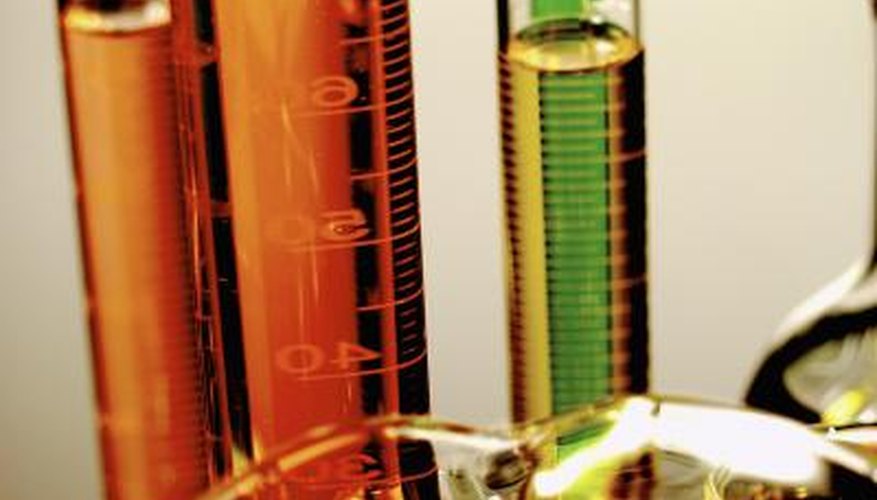A dilution solution contains solute (or stock solution, aliquot) and a solvent (called diluent). These two components proportionally combine to create a dilution. You can identify a dilution solution by the amount of solute in the total volume, expressed as a proportion. For example, a chemical may be prepared in a 1:10 dilution of alcohol, indicating that a 10ml bottle contains one millilitre of chemical and nine millilitres of alcohol. Students can calculate the necessary volume of each component to prepare a dilution solution and calculate the dilution factor based on known volumes of the solution.
- A dilution solution contains solute (or stock solution, aliquot) and a solvent (called diluent).
- You can identify a dilution solution by the amount of solute in the total volume, expressed as a proportion.
Write down the final volume of the solution--for example, 30ml.
Write down the desired dilution in the form of a proportion--for example, 1:20 dilution, also known as the dilution factor.
Convert the dilution factor to a fraction with the first number as the numerator and the second number as the denominator. For example, a 1:20 dilution converts to a 1/20 dilution factor.
Write down the formula to determine the needed volume of the stock solution, also known as the aliquot: final volume (in step 1) x dilution factor (step 3)--for example, 30ml x 1/20 from steps 1 and 3, respectively.
Calculate the amount of stock solution required--for example, 30ml x 1/20 = 1.5ml.
Subtract the amount of stock solution (step 5) from the total volume (step 1) to calculate the volume of diluent required--for example, 30ml - 1.5 mL = 28.5ml.
- Convert the dilution factor to a fraction with the first number as the numerator and the second number as the denominator.
- Subtract the amount of stock solution (step 5) from the total volume (step 1) to calculate the volume of diluent required--for example, 30ml - 1.5 mL = 28.5ml.
Measure the amount of stock solution required (step 5) and dispense this into a large measuring cup. For example, dispense 1.5ml of aliquot into a 50-mL measuring cup.
Measure the amount of diluent required (step 6) and dispense this into the large measuring cup. For example, dispense 28.5ml of diluent into the 50-mL measuring cup containing 1.5ml aliquot to obtain the desired dilution solution.
Measure the total volume of the solution--for example, 25ml.
Write down the volume of stock solution (or aliquot) or diluent used in the solution--for example, 10ml of aliquot; alternatively, 20ml diluent.
Subtract the diluent volume (step 2) from the total volume of the solution (step 1) to calculate the volume of aliquot used, if the volume of stock solution (aliquot) isn't known--for example, 25ml total volume - 20ml diluent = 5ml aliquot.
- Measure the amount of diluent required (step 6) and dispense this into the large measuring cup.
- Subtract the diluent volume (step 2) from the total volume of the solution (step 1) to calculate the volume of aliquot used, if the volume of stock solution (aliquot) isn't known--for example, 25ml total volume - 20ml diluent = 5ml aliquot.
Write down the proportion for the dilution--dilution factor = volume of aliquot : total volume.
Insert the known values to calculate the dilution factor and simplify. For example: Aliquot from step 2 = 1ml. Dilution factor = 10ml : 25ml simplifies to 2:5. Aliquot from step 3 = 5ml. Dilution factor = 5ml : 25 mL = simplifies to 1:5.
